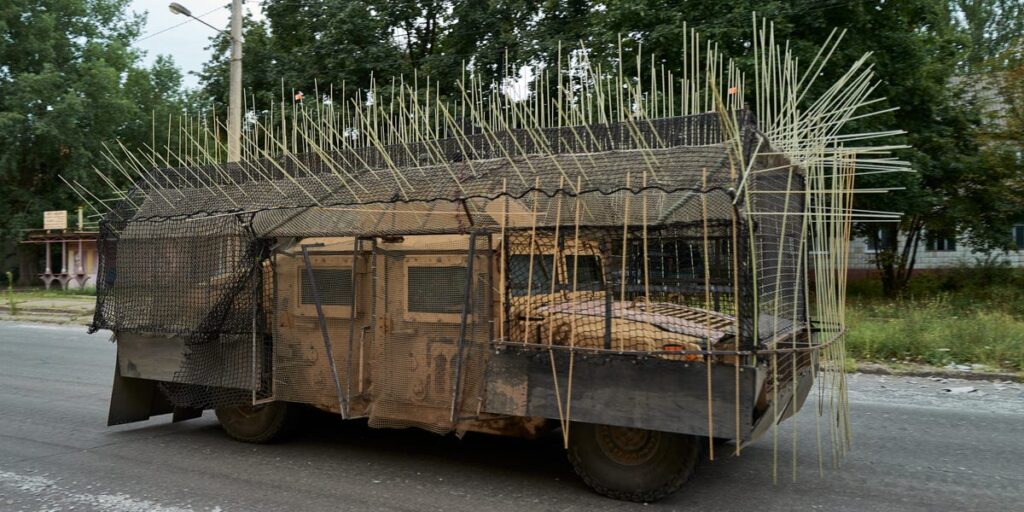Cage armor on Ukrainian and Russian combat vehicles continues to get wilder, resembling the heavily customized, postapocalyptic cars from the “Mad Max” films and video games.
The latest example of this makeshift armor, meant to shield the vehicles and their crews against drone attacks, showed up in a photo taken Monday, the protective armoring covering what appears to be an American-made Humvee. The photo of the Ukrainian vehicle was taken in Kostiantynivka, north of Donetsk.
The vehicle was surrounded by a large metal cage, netting, and sticks protruding from the top and sides.
Images like this one capture the ongoing efforts to keep military vehicles safe from the threat of drones, a top battlefield killer, and show how cheap uncrewed vehicles are changing warfare.
The armoring isn’t standardized, with soldiers on both sides of the war often taking a DIY, or do-it-yourself, approach.
Russia, like Ukraine, has been bulking up its vehicles with the protective add-ons, so much so in some cases that it is impossible to tell what the vehicle even is. Last month, combat footage showed what observers identified as a Russian tank shielded by a large cage, significant amounts of netting, and some other material.
Protective screens, improvised armor sometimes described as “cope cages,” began to show up on the battlefield in 2023, just as drones were becoming a more prolific problem. Cheap ones costing around a few hundred bucks have taken out multi-million-dollar tanks. With drones becoming more dominant in battle, these screens have since become more prominent.
The cage armor often varies in appearance and overall effectiveness, with some looking jury-rigged and crudely built and others more thoughtfully implemented. At first, these cages were really only observed on tanks and armored fighting vehicles, but they have since spread to a range of combat systems.
The armoring efforts include metal cages, netting, chains, protruding spikes, metal plates, and more, sometimes alongside additional explosive reactive armor to help defend the most vulnerable areas of the vehicle.
Examples of these so-called cope cages include complex, heavy structures that could impact the speed and movement of the vehicles. Others have featured camouflage material and netting. Some of Russia’s cages have also been described as “turtle tanks” as the armor resembles a turtle’s shell, covering the entire tank.
These cages could protect against some anti-tank weapons and first-person-view drones, but there are questions about the impact on operations.
Since their introduction, some designs have become standard, with militaries and defense companies applying them to the combat vehicles.
Russia’s military actually has instructions and designs for the construction of these cages, and Ukrainian companies have adapted the protective steel screens for Kyiv’s Soviet-designed T-64 and T-72 tanks to its US-provided Abrams tanks, Bradley fighting vehicles, Patriot air defense systems, and more.
The threat of drones, especially cheap, hobby-style ones packed with explosives, to tanks and armored vehicles and really anything that moves on the battlefield has been a dominant element of the Ukraine war. Both Russia and Ukraine have extensively used these UAVs and demonstrated the asymmetric advantage they can bring in damaging or destroying an expensive tank or injuring or killing its crew.
These cages are last-ditch defenses against drones. Other ways Russia and Ukraine have taken to countering these threats include electronic warfare, which is rampant on the battlefield, severing the connection between the operator and the drone or interfering with its GPS and location data.
Countermeasures to electronic warfare, though, have also been on the rise. Last year, Russia began using fiber optic drones, which feature a hard wire connecting the operator to the drone to maintain a stable connection. Now, Russia and Ukraine are increasingly employing fiber optic drones, leaving some areas of the battlefield covered in wires. AI-enabled drone technology is also being sent into combat more frequently, allowing the machine to push on even if a connection is broken.
Read the full article here
















